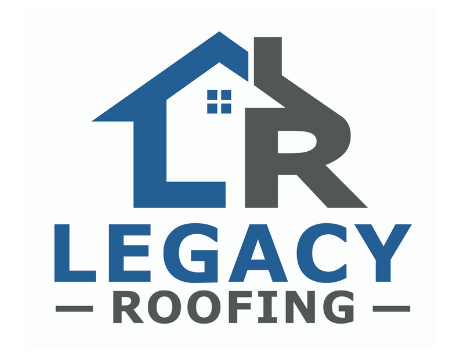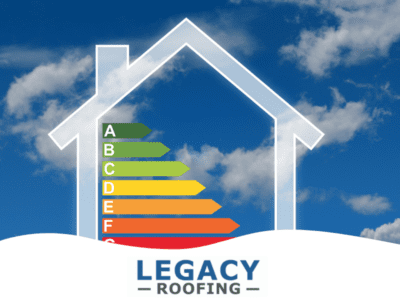Are you finding yourself wondering what the most energy-efficient roofing option is?
An energy-efficient house starts with an energy-efficient roof considering the amount of air that flows in and out of your roof! Here at Legacy Roofing of Idaho, we understand the importance of selecting suitable roofing materials when considering a new roof project.
Roofs are a large ticket item for most homeowners but knowing that energy-efficient roofs can help save money is essential. We created this article to help you learn about the most energy-efficient roofs!
>> Ready for a new roof? Reach out here to get a consultation!
First, what is an energy-efficient roof anyway?
The best way to envision your roof is as a breathing organism.
Bear with us for a moment, but your roof has air intake from the soffit vents around the underside of your roof, followed by air ventilation through the ridge vents, attic vents, and other electric/wind vents.
This is designed to let air escape and your roof “Breathe” to prevent moisture from damaging the integrity of your roofing materials and roofing structure. Naturally, if your roof is more efficient in how it reflects the sun in the summer or attracts it in the winter, you can save money on your energy bill. In some cases, you can even get a tax credit!
Note: You can learn more about Energy Star Ratings and credits here.
Benefits of Energy Efficient Roofs:
An energy-efficient roof can naturally save you money on your energy bill. It can also be an upsell if you ever go to sell your home. Overall, an energy-efficient roof can offer the following benefits, according to Roof Simple:
- It lowers maintenance costs.
- It adds to your property value or resale value.
- It extends the life of your roof
- It extends the life of your HVAC system.
- It makes your home more comfortable.
Most Energy-Efficient Roofing Materials:
Below are some of the top picks for energy-efficient roofing materials to choose from that are relatively within a standard roof replacement budget. For cost purposes, a roof using metal will be the most expensive, followed by tiles and asphalt roofing materials.
This also happens to be the order of the MOST efficient roofing material – metal, tiles, asphalt.
Metal Roofing
While a metal roof or tile roof is a toss-up for the most energy-efficient roof, they are also the most expensive. Roofing material is generally picked for aesthetic purposes and durability, followed by their energy efficiency.
Metal roofs are known to be more reflective than their asphalt shingle counterparts, but they are also more expensive to install and replace (See the difference between metal roofing and asphalt shingles below).
Asphalt Shingles

Asphalt shingles have had the reputation of being less energy efficient than their metal or tile counterparts. However, asphalt shingles have become more energy efficient with an emphasis on creating more energy-efficient roofing shingles.
Unlike a metal roof that can reflect heat, asphalt shingles typically don’t reflect heat very well. Luckily, they do now have brands with reflective granules that can help make them a more energy-efficient roofing material.
From our standpoint, the overall energy savings of a new roof will not make up the difference between a metal roof and an asphalt shingle roof.
Translation: If you are considering getting a metal roof because of energy savings, the price will be higher for a metal roof and won’t save you money. There are other ways to ensure your home is energy efficient with things like attic space solutions, attic vents, insulation, and other means.
Other
Of course, the main two types of roofing materials – asphalt shingles and metal roofs – tile roofs, cedar shake roofs, and so on can offer energy efficiency.
Tile roofing, for example, can have reflective technology but also cost a pretty penny. In general, if you’re living in the upper North West part of the country, you will typically choose between asphalt shingles or metal roofs.
Other ways to make your house energy efficient!
Believe it or not, you can make your home more energy efficient without replacing your roofing materials. Sure, if you need a new roof, it isn’t a bad idea to consider energy-efficient methods, but that doesn’t mean you have to splurge.
An asphalt shingle roof replacement is going to meet standard energy thresholds, and you can also consider some of the following methods:
- Add insulation
- Check for the caulking around windows and doors
- Consult with an energy-efficient company to see how you can reduce energy costs
- Find ways to create airflow in your house (Update the HVAC system, see if you can shift your vents, and get your system serviced)
- Have your attic vents and ridge vents inspected
- Make your existing roof more energy efficient by replacing it with an energy-efficient roofing system.
If your roof is ten years older or more, chances are the rapid technology advancements in roofing materials didn’t occur with your roof. Even in the last five years, tons of research (reflective granules) and methods have made roofing materials more energy efficient.
Thus, this makes your new roof energy efficient. It is crucial to remember that not all asphalt shingles are created the same and top manufacturers tend to manufacture the most sustainable roofing materials (Timberline, Owens Corning, CertainTeed).
If you are looking for a cool roof (in looks and efficiency) and it is time to consider replacing your existing roof, don’t hesitate to ask the team at Legacy Roofing of Idaho to help you with a consultation.
We strive to use the best energy-efficient materials so you can have the best roof on the block, and while you’re at it, reduce some of your energy bills!
Note: If you are considering getting solar panels, keep in mind that installing them on a new or newer roof is best. Putting new solar panels in place can save on energy bills and help promote a green home, but don’t forget that they are often mounted on a roof. So the roof needs to be in great shape!


 6 Simple Ways to Add Value to Your Home
6 Simple Ways to Add Value to Your Home